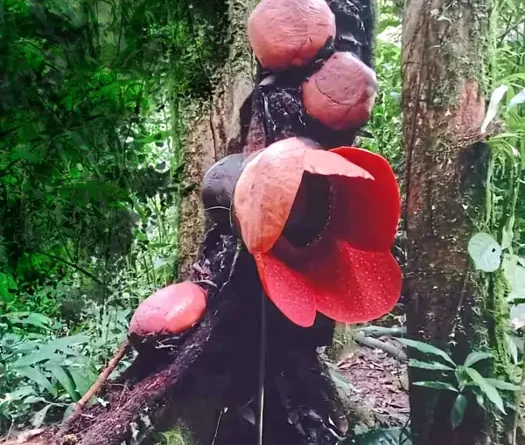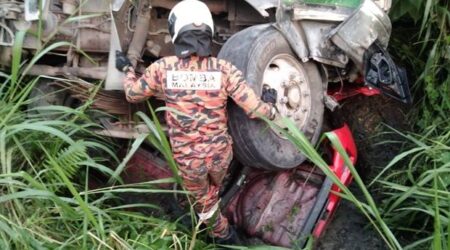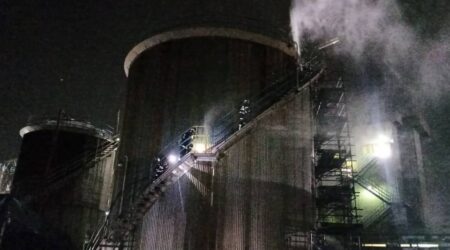Big, bold, stinky: The Rafflesia flower is a rotting spectacle in the highlands
You spot it on RM10 notes – a crimson marvel the size of a truck tyre.
This is the Rafflesia, the world’s largest flower, a botanical oddity as infamous as it is rare.
Nicknamed the stinking corpse lily, its Indonesian moniker bunga bangkai (carcass flower) hints at its olfactory punch.
But whether you’re hit by a wave of rotting flesh or a whiff of vinegar depends on your nose – and luck.
“To me, it’s pickles. My mum found massive ones in Sabah that stank like week-old roadkill,” laughs mountain guide Krystal Khaw.
Al Edi Jaafar, a 46-year-old Cameron Highlands hiking leader, wrinkles his nose: “It’s more like sour rubbish.”
Based in Lojing, Kelantan – a misty village 1,500m above sea level – he’s spent years trailing these floral giants.
When a Rafflesia blooms, he says, its putrid perfume travels 10-20m in the first three days, luring carrion flies with the false promise of a feast.
The Rafflesia defies botany textbooks.
The parasitic plant has no stems, leaves, or roots. It survives by leaching nutrients from certain vines and only its flowers are visible.
For years, it grows invisibly within the vine – until a cabbage-like bud erupts through the bark.
Five days later, the flower unfurls into a fleshy, five-petalled disk up to a metre wide.
“It’s like a magic trick,” says Al Edi. “One day, there’s nothing. The next, a monstrous bloom.”
But the real showstopper is the pop when it opens.
“Some swear it’s a firecracker, but it’s softer – like a cork,” he grins. “Stand there when it happens, though, and the stench hits you like a truck.”
The stink isn’t just theatrics. The Rafflesia mimics rotting meat to attract pollinators: flies and beetles that scuttle across its mucus-coated centre, inadvertently ferrying pollen.
However, this survival tactic has a shelf life. The flower withers in six to seven days, leaving behind a “rotten banana”-like mush.
Finding one is a treasure hunt. Buds can take nine months to mature, and blooms are fleeting.
“It’s 90% patience, 10% luck,” admits Al Edi.
Treks range from a breezy 15-minute stroll to a four-hour slog through slippery trails.
In Lojing’s protected 400ha – part of Cameron Highlands ecosystem – trackers from the Orang Asli indigenous community scout daily for buds.
“When we find one, we check the area like detectives,” Al Edi explains. “Baby buds are tiny – smaller than your palm – and buried under leaves. One misstep can crush them.”
Visitors must tread carefully: Rafflesia’s rarity isn’t just natural. Habitat loss and trampling tourists threaten its survival.
Eco-guides enforce strict protocols.
“Never wander off-path. Never touch the flower,” Al Edi stresses.
Human hands transfer bacteria and fungi, which can kill buds. Even rainwater pooling on petals – a common issue in Cameron Highlands’ drizzly climate – can trigger rot.
Conservation is a community effort and the Orang Asli, with their ancestral knowledge of the forest, partner with guides to monitor blooms.
“They’ve tracked these flowers for generations. Without them, we’d lose countless buds,” says Al Edi.
The Cameron Highlands’ Rafflesia blooms year-round, but odds improve in drier months (January-March).
Trails are beginner-friendly but muddy. Wear hiking boots with deep treads, and layer up: temperatures dip to 15°C.
A lightweight waterproof jacket is essential – downpours are sudden.
Most tour operators charge RM90 per person for group hikes, including transport from Tanah Rata.
Private groups pay RM300-400, covering 4×4 rides and dedicated Orang Asli trackers.
“For couples, families or photographers, privacy lets you take time with the flowers,” says Al Edi.
After the trek, you can warm up with Cameron Highlands’ signature steamboat dinner or a pot of Boh Tea. But the Rafflesia’s haunting allure lingers.
“People think it’s just a smelly flower,” says Al Edi.
“But when you see it up close, you realise it’s a miracle.”
Beyond its shock factor, the Rafflesia is an ecological barometer. Thriving only in pristine rainforests, its presence signals a healthy ecosystem.
Conservationists are push to preserve Cameron Highlands’ forests, hoping to curb illegal farming and deforestation.
For now, the flower remains a fragile icon – a reminder of nature’s capacity for wonder and grotesquery.
As Al Edi says: “You don’t just see the Rafflesia. You experience it with all your senses… even the ones you’d rather not.”
To book a tour, contact Al Edi Jaafar at 014-302 4585 or 010-666 4585.



















Leave a Reply